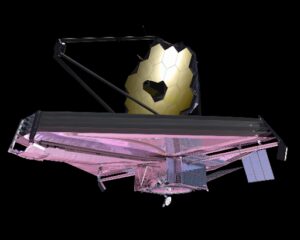Space Telescopes

The James Webb Space Telescope studies every phase in the history of our Universe, ranging from the first luminous glows after the Big Bang, to the formation of solar systems capable of supporting life on planets like Earth, to the evolution of our own Solar System. Webb launched on Dec. 25th, 2021. It does not orbit around the Earth like the Hubble Space Telescope; it orbits the Sun 1.5 million kilometers (1 million miles) away from the Earth at what is called the second Lagrange point or L2.
Here are three links that provide valuable information about this amazing telescope.
James Webb Space Telescope - NASA Science
https://science.nasa.gov/mission/webb
https://webb.nasa.gov/content/about/index.html
https://jwst.nasa.gov/content/about/launch.html
You can also use you search engine and find a large number of articles about the James Webb Telescope in many magazines and other news sources. Happy Hunting.

Since its 1990 launch, the Hubble Space Telescope has changed our fundamental understanding of the universe. Below is a link that will let you explore this amazing telescope and its amazing space photos:
Written and fact-checked by The Editors of Encyclopedia Britannica
Astronomical observatories are structures containing telescopes and auxiliary instruments with which to observe celestial objects. Telescopes provide a means of collecting and analyzing radiation from celestial objects, even those in the far reaches of the universe. This is a list of astronomical observatories and telescopes ordered alphabetically by location. (See also astronomy; radio and radar astronomy; radio telescope; space exploration.)
- Cerro Tololo Inter-American Observatory
- European Southern Observatory
- Gemini Observatory
- Las Campanas Observatory
- U.S. National Radio Astronomy Observatory